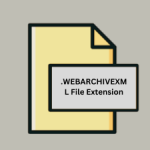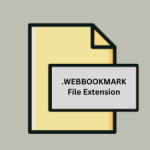.DISCO File Extension

What is an DISCO file?
The .DISCO file extension represents a type of document known as a DISCO Discovery Document. These files are primarily used in web service discovery processes.
They are part of a broader suite of tools designed to facilitate interaction and data exchange between disparate software systems.
Understanding .DISCO files requires a look into their origin, purpose, technical specifications, and practical implications.
More Information.
The .DISCO file format emerged in the early 2000s alongside the development of web services technologies like SOAP (Simple Object Access Protocol) and WSDL (Web Services Description Language).
The primary purpose of the .DISCO file was to simplify the discovery of web services within the .NET ecosystem. It allows developers and applications to locate and interact with services exposed by web servers.
Initially, .DISCO files were used in conjunction with ASP.NET applications to provide a discoverable list of web services.
The introduction of .DISCO files was part of Microsoft’s broader strategy to support service-oriented architecture (SOA) and enhance web service integration.
Origin Of This File.
The .DISCO file format was introduced by Microsoft as part of the .NET Framework, which was developed to enhance software interoperability and service discovery. The .DISCO file format specifically caters to the discovery of web services.
Its introduction came with the rise of web-based services and the need for a standardized approach to accessing and managing these services in a networked environment.
File Structure Technical Specification.
.DISCO file is an XML-based file that contains metadata about web services. This metadata includes information about the service’s location, its available methods, and how to interact with those methods. The file typically includes the following components:
- Header Information: This section provides general information about the web service, such as its name and description.
- Service Listings: The core of the .DISCO file consists of a list of web services that are available for discovery. Each entry includes a reference to a WSDL file, which defines the operations that the service can perform.
- Endpoints: The file specifies the endpoints for each service, detailing the URLs where the services are accessible.
- Metadata: Additional metadata may include versioning information, security details, and other relevant configuration settings.
How to Convert the File?
Converting a .DISCO file to another format generally involves transforming its XML content into a different format that is better suited to modern applications. For example:
- To WSDL: Since .DISCO files reference WSDL files, you can often convert the .DISCO file’s references directly into WSDL format. This involves extracting the URLs from the .DISCO file and using them to retrieve the corresponding WSDL files.
- To OpenAPI: Converting .DISCO content to OpenAPI (formerly Swagger) requires a more detailed transformation. You will need to manually translate the XML-based metadata into JSON or YAML format used by OpenAPI.
Several tools and libraries can aid in these conversions, but manual intervention may be necessary to ensure accurate transformation.
Advantages And Disadvantages.
Advantages:
- Standardized Discovery: .DISCO files provide a standardized way to discover web services, which simplifies integration across different systems and platforms.
- Automation: Tools and frameworks that support .DISCO files can automatically discover and integrate with web services, reducing the need for manual configuration.
- Service Enumeration: By listing available services and their endpoints, .DISCO files facilitate easier management and usage of web services.
Disadvantages:
- Limited Adoption: With the evolution of web services technologies, the use of .DISCO files has declined. More modern discovery mechanisms, such as those provided by RESTful services or OpenAPI, are now more prevalent.
- Security Concerns: Exposing service metadata in a .DISCO file can potentially lead to security risks if sensitive information is not properly protected.
- Compatibility Issues: As technology evolves, newer systems and frameworks may not support .DISCO files, leading to compatibility issues in some cases.
How to Open DISCO?
Open In Windows
- Visual Studio: As a Microsoft product, Visual Studio can open and parse .DISCO files natively. You can use it to view and edit the file, or to generate service proxies.
- Text Editors: Any text editor, such as Notepad++ or Visual Studio Code, can open .DISCO files since they are XML-based. However, they won’t provide specific service-related functionality.
Open In Linux
- Command-Line Tools: Tools such as
cat,less, orvimcan be used to view .DISCO files in the terminal. XML formatting can be handled with additional tools likexmlstarlet. - Text Editors: Graphical text editors like Gedit or Kate provide a user-friendly way to view and edit .DISCO files.
Open In MAC
- Text Editors: Similar to Windows, you can use text editors like Sublime Text or Atom to open and view .DISCO files. They offer syntax highlighting for XML, which can make reading easier.
- Integrated Development Environments (IDEs): While macOS does not have Visual Studio, IDEs like IntelliJ IDEA or Eclipse can be used with appropriate plugins to work with XML files, including .DISCO.













